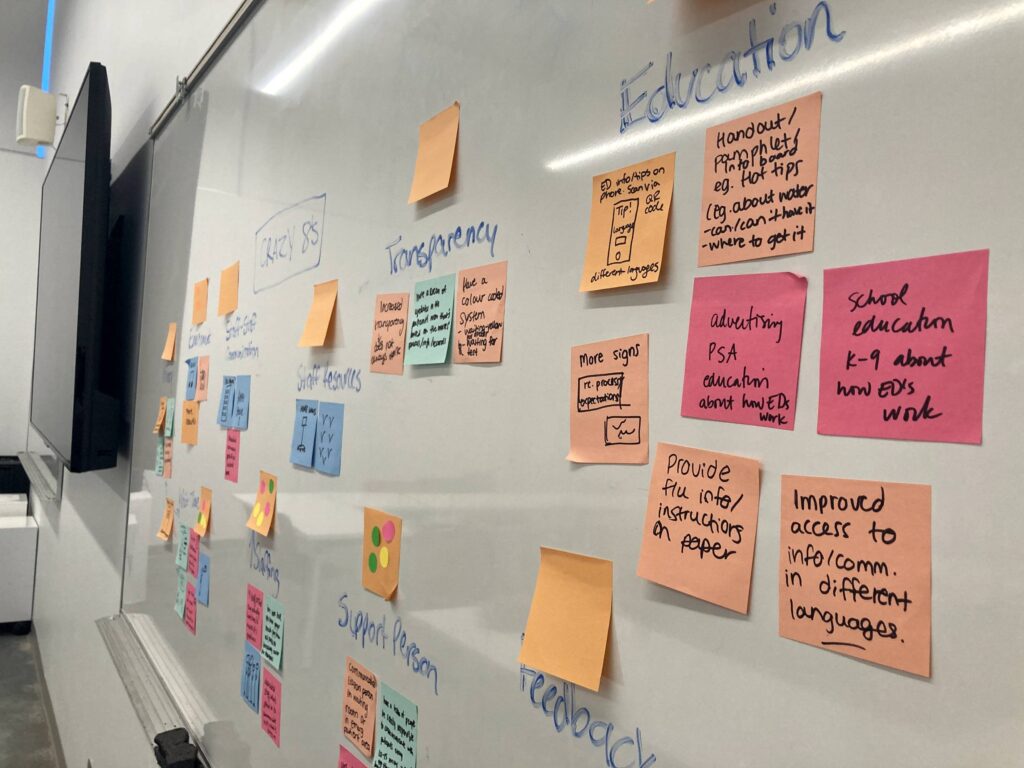The Heartbeat of Emergency Care:
Co-creating a Redesigned Experience Through a Service Design Approach
Please note, this case study is a student project and is not affiliated with Vancouver Coastal Health.
The Big Picture
The Context
Emergency departments (EDs) can be high stress, fast-paced environments that pose challenges for both the public and staff. With both my teammate and I having healthcare backgrounds and myself having worked in an ED, we were familiar with many of these challenges. Recognizing the limitations of the current healthcare system, we saw an opportunity to redesign the ED experience to benefit both the public and staff.
The Problem
Based on our experiences in healthcare, we identified the ED as a key area where negative experiences of both the public and staff can lead to a loss of trust and feeling unsupported by the healthcare system. This is concerning as EDs are foundational to hospitals and often set the tone for a person’s overall experience, so we developed our initial research question:
The Solution
We took a service design approach to this problem, including the public and ED staff in an in-person co-design workshop. This led to the development of a service blueprint for an improved ED process, which includes wait-time procedures designed to enhance communication and transparency for the public while streamlining workflows for staff. This included a digital check-in kiosk, which we designed and prototyped.
The Story Behind the Solution
To provide structure for our design approach, we followed the Service Design Thinking process, as outlined by Marc Stickdorn and Jakob Schneider.
The Anatomy of an ED: Understanding the Experience
To conduct our research, we carried out site observations at three emergency departments and one urgent and primary care centre located in Vancouver. We also conducted six qualitative interviews, including three with individuals who had visited an ED within the past year, and three with ED staff members. To supplement our findings, we conducted secondary research on ED trends and factors influencing the public and staff experience.
Empathizing with The Public’s Uncertainty & ED Staff’s Overwhelm
Through our research, we were able to empathize with the perspectives and concerns of both the public and staff. From the public’s standpoint, we found that they often experience frustration due to feeling uninformed, helpless, and anxious when seeking medical assistance. On the other hand, the ED staff reported feeling overwhelmed by their workload and low staffing levels, leading them to feel unable to provide optimal patient care.
Seeing the Whole Picture
Across our observations, interviews, and secondary research, we analyzed our data to look for patterns. Using affinity mapping and dot prioritization, we found three key insights that guided our approach to the project.
Effective Communication
Caring Environment for the Public
Compassion & Support for Staff
Narrowing in on Communication
Based on our research data, we decided to narrow our scope to focus on effective communication as the highest priority. Indirectly, enhancing communication would also have a positive impact on the other two insights. That led us to a refined research question:
Telling a Story
Guided by the findings of our interviews, we used LEGO to create a storyboard that visually depicts the user journey of a person visiting an emergency department. By building the individual steps in the storyboard, we were able to gain a deeper understanding of the process and then pain and gain points.
Uncovering the Complexities of the Current Process
To ensure we captured all aspects of the current ED process, we created a service blueprint that documents the steps involved for both the public and staff.
Co-Designing Solutions for Change
After gaining a thorough understanding of the current process, we facilitated a co-design workshop with members of the public and ED staff to collaborate on mutually beneficial solutions for change. Through activities such as crazy 8’s, affinity mapping, and dot prioritization, participants generated and prioritized ideas for innovation.
Walking Through an Updated Process
Equipped with new ideas, the participants brought them into action by creating a desktop walkthrough to quickly simulate an updated ED process. This represents an initial step towards an improved ED experience according to the participants’ perspectives.
Integrating New Communication Ideas
After reviewing the workshop ideas, we assessed which were the highest priority to implement in an updated ED process. We then integrated the most critical opportunities (highlighted in pink) into the service blueprint. Most of these changes were incorporated at the check-in phase, including a new wait time ticketing system and check-in kiosk.
Designing an Optimized ED Check-In
We designed the check-in kiosk to streamline registration for those with non-urgent medical needs. The kiosk efficiently collects personal health information, issues a wait-time ticket, and provides a QR Code to access ED visit information such as tips and estimated wait times. To accommodate a diverse user group, there are accessibility features and language options to minimize language barriers.
Evaluating Effectiveness
Using IDEO’s Design Thinking framework, we find our proposed solutions to be desirable, feasible, and viable. They support communication, streamline processes, and ideas such as ticketing systems and check-in kiosks have been successfully implemented in other EDs in North America. Furthermore, these ideas are in alignment with B.C.’s Digital Health Strategy, as they would help to empower patients and improve the provider experience.
Looking Ahead to Implementation
To move into the implementation stage of this project, we would do further testing to iterate on our service blueprint and check-in kiosk. To take this project one step further, we would consider engaging Vancouver Coastal Health or another health authority.
Reflecting on Lessons Learned
This project challenged me in many ways and helped me grow as a designer. Throughout the process, I gained valuable learnings and reflections.





















